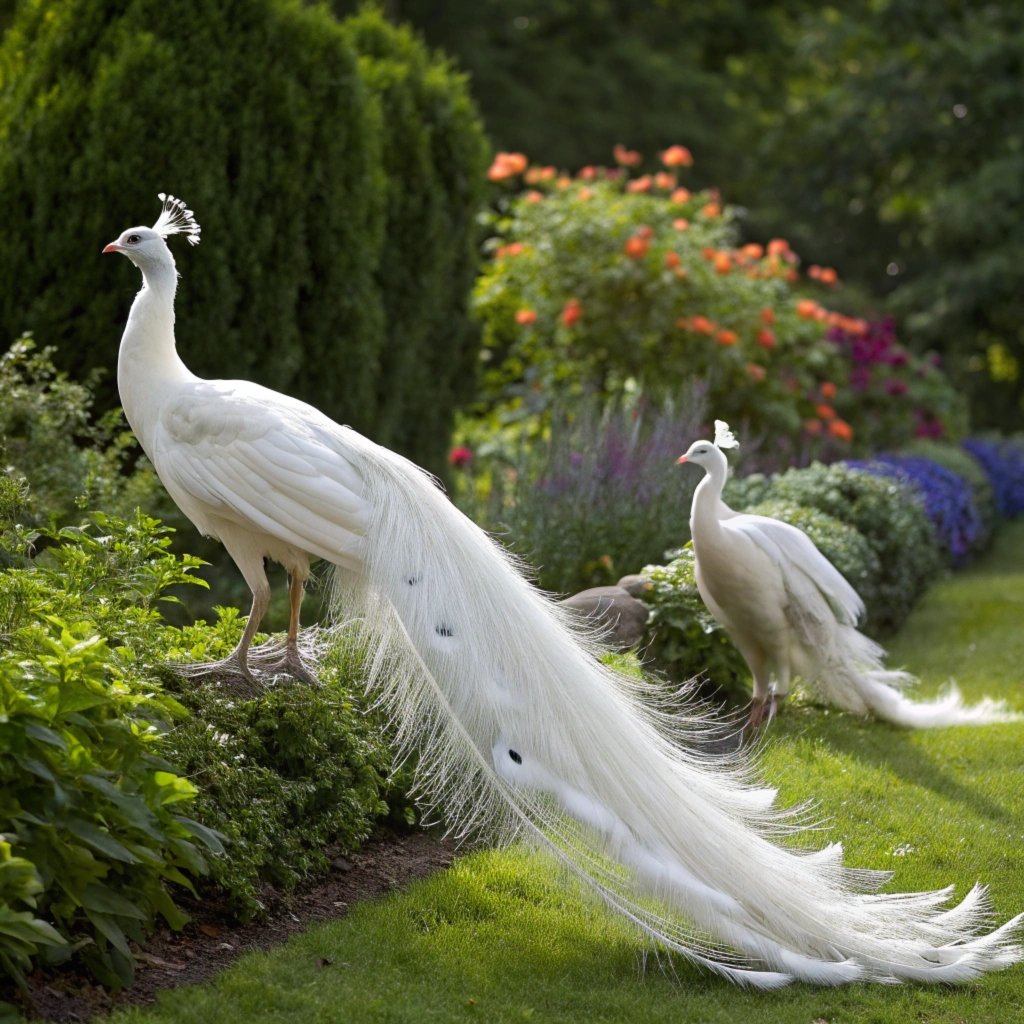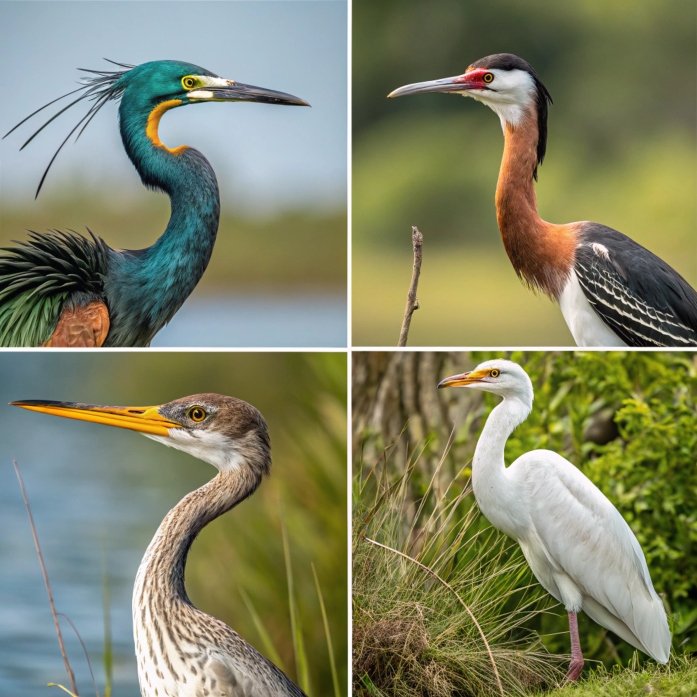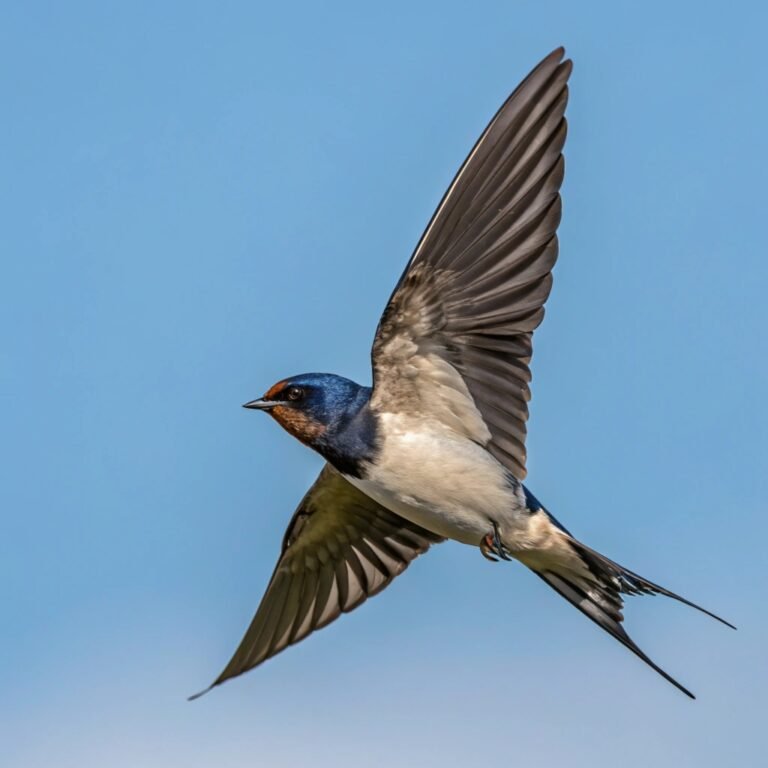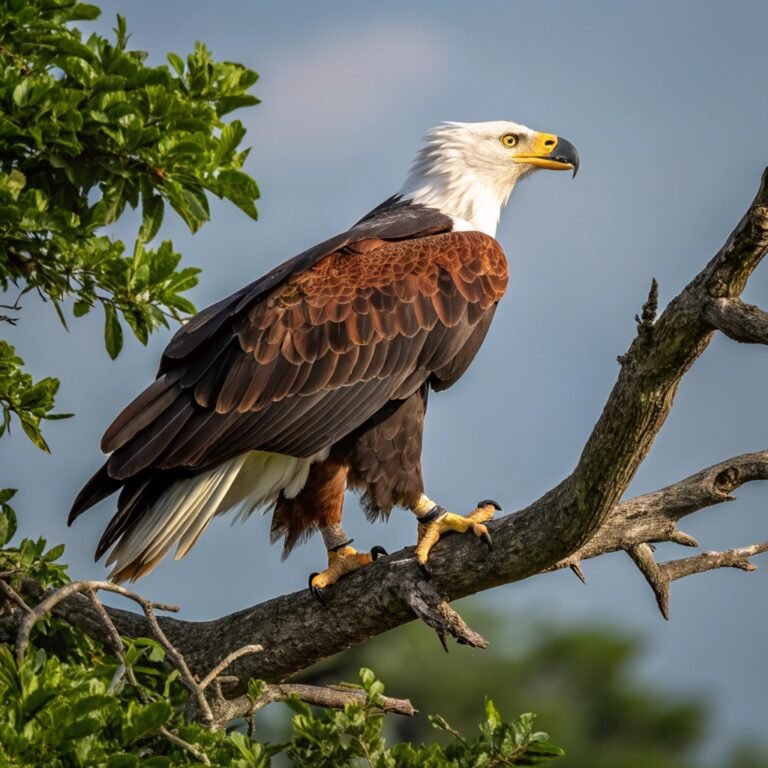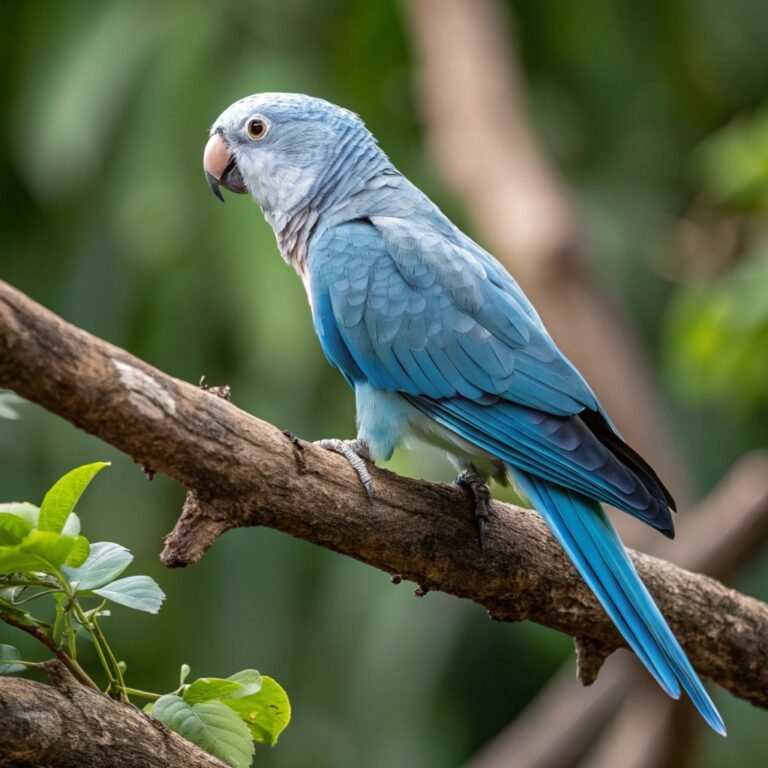The Enigmatic White Peacock: Nature’s Rarest Avian Gem and Its Majestic Beauty
The white peacock, a rare and captivating variant of the Indian peafowl, stands as a testament to nature’s ability to create extraordinary beauty.
This magnificent bird, with its pristine white plumage and regal bearing, has long fascinated bird enthusiasts, researchers, and nature lovers alike.
In this comprehensive exploration, we’ll delve into the world of the white peacock, uncovering its origins, unique characteristics, and the symbolism it holds in various cultures.

Key Takeaways: The Essence of White Peacocks
- Genetic Marvel: White peacocks are not a separate species but a result of a genetic mutation called leucism.
- Rarity in Nature: These birds are extremely rare in the wild, with only about 1 in 30,000 peacocks being white.
- Not Albino: Unlike albino animals, white peacocks have blue eyes and normal skin pigmentation.
- Cultural Significance: In many cultures, white peacocks symbolize purity, spirituality, and good fortune.
- Captive Breeding: Most white peacocks are found in captivity, where they are bred for their unique appearance.
- Historical Presence: The first recorded white peacocks appeared in the 1830s, though they may have existed earlier.
- Adaptability: White peacocks can thrive in various climates but prefer tropical environments.
- Lifespan: In captivity, these birds can live up to 25 years or more.
- Size Variation: Male white peacocks are typically larger, reaching 39-45 inches in height.
- Tail Feathers: The iconic tail feathers, or coverts, can make up more than 60% of the bird’s total length.
The Origins of the White Peacock: A Genetic Wonder
The white peacock is not a distinct species but rather a color variant of the Indian Blue Peacock (Pavo cristatus).
This stunning mutation first caught the attention of breeders and naturalists in the 1830s, following the British colonization of India.
The genetic phenomenon responsible for their white plumage is known as leucism, a condition that causes a partial loss of pigmentation in an animal’s feathers, hair, or skin.
Unlike albinism, leucism does not affect the eyes, allowing white peacocks to retain their characteristic blue eye color.
This genetic quirk is exceedingly rare in the wild, making white peacocks a true marvel of nature’s diversity.
Habitat and Distribution: Where White Peacocks Thrive

While white peacocks are primarily found in captivity, their wild counterparts inhabit various regions across the Indian subcontinent and Southeast Asia.
These majestic birds adapt well to diverse environments, from the arid landscapes of Rajasthan to the lush forests of Kerala in India.
In captivity, white peacocks have been successfully bred and introduced to many parts of the world, including Europe and North America.
They prefer tropical climates but can adjust to different weather conditions with proper care.
The rarity of white peacocks in the wild is likely due to their conspicuous appearance, which would make them easy targets for predators, highlighting the importance of conservation efforts and controlled breeding programs.
Physical Characteristics: The Allure of White Plumage
The white peacock’s most striking feature is undoubtedly its pristine white feathers, which create a stunning contrast against any backdrop.
Male white peacocks, known as peacocks, boast the iconic long tail feathers or coverts that can make up over 60% of their total body length.
These elaborate tail feathers take up to three years to fully develop. Female white peacocks, called peahens, lack the extravagant tail but still possess elegant white plumage.
Both sexes have blue eyes, distinguishing them from albino birds. White peacock chicks are born with a pale yellow down, gradually developing their white feathers as they mature.
The average size of a male white peacock ranges from 39 to 45 inches in height, while females are slightly smaller, typically measuring 37 to 40 inches.
Behavior and Lifestyle: The Daily Rhythms of White Peacocks

White peacocks share many behavioral traits with their colorful counterparts. These birds are primarily ground-dwelling, foraging for berries, grains, insects, and small reptiles.
Despite their large size and long tail feathers, white peacocks are capable of flight, though they prefer to escape danger by running.
They are known for their distinctive calls, which serve as both a mating ritual and a warning system in their natural habitats.
White peacocks are social creatures, often found in small groups called musters, typically consisting of one male and several females.
During the breeding season, males engage in elaborate courtship displays, fanning out their magnificent tail feathers to attract mates.
These birds are most active during the early morning and late afternoon, often seeking shelter during the hottest parts of the day.
Breeding and Reproduction: The Cycle of Life for White Peacocks
The breeding habits of white peacocks are fascinating and complex. The mating season typically begins in early spring and can last through early autumn.
Male white peacocks perform elaborate courtship rituals, which include fanning out their impressive tail feathers and performing a dance-like strut.
Females choose their mates based on the quality and appearance of these displays. Once mated, the female white peahen will lay a clutch of 3 to 8 eggs in a shallow nest on the ground.
The incubation period lasts about 28 days, during which the female is solely responsible for tending to the eggs.
White peachicks are born with a pale yellow down, which gradually transforms into white feathers as they grow.
The chicks are precocial, meaning they can walk and feed themselves shortly after hatching, though they remain under their mother’s care for several months.
Cultural Significance: The White Peacock in Human Imagination
Throughout history, the white peacock has held a special place in various cultures and belief systems. In many societies, these rare birds are seen as symbols of purity, divinity, and spiritual awakening.
In Christian art, white peacocks have been used to represent Jesus Christ, symbolizing resurrection and eternal life.
In Hindu mythology, the peacock is associated with several deities and is considered sacred.
The Order of the White Peacock, an ancient shamanic tradition, views these birds as protectors and guardians of spiritual wisdom.
In literature and art, white peacocks often appear as symbols of beauty, luxury, and sometimes vanity.
Their rarity and striking appearance have made them popular subjects in various forms of artistic expression, from paintings and sculptures to poetry and prose.
Conservation Status: Protecting Nature’s White Wonder
While the Indian Blue Peacock is not considered endangered, the white peacock variant requires special attention due to its rarity.
In the wild, white peacocks face challenges due to their conspicuous appearance, making them easy targets for predators.
Additionally, habitat loss and human encroachment pose threats to peafowl populations in general.
Conservation efforts for white peacocks primarily focus on captive breeding programs and maintaining genetic diversity within these populations.
Zoos, wildlife parks, and private breeders play crucial roles in preserving and studying these unique birds.
Education and awareness programs are also essential in promoting the conservation of white peacocks and their habitats, ensuring that future generations can continue to marvel at these extraordinary creatures.
White Peacocks in Captivity: Care and Management
Keeping white peacocks in captivity requires specialized knowledge and dedicated care.
These birds need spacious enclosures that allow them to express natural behaviors, including foraging and displaying their feathers.
A balanced diet consisting of commercial peafowl feed, supplemented with fruits, vegetables, and insects, is essential for their health.
White peacocks are generally hardy birds but can be susceptible to certain diseases and parasites, necessitating regular veterinary check-ups.
Proper shelter is crucial to protect them from extreme weather conditions and predators. In captivity, white peacocks can live up to 25 years or more with proper care.
Breeding white peacocks requires careful genetic management to maintain the purity of the white coloration while avoiding inbreeding.
Many zoos and private breeders participate in breeding programs to ensure the continuation of this rare and beautiful variant.
The Genetic Mystery: Understanding Leucism in White Peacocks
The white plumage of these peacocks is a result of a genetic condition called leucism, which is different from albinism. Leucism causes a partial loss of pigmentation in an animal’s feathers, hair, or skin, but unlike albinism, it does not affect the eyes.
In white peacocks, this genetic mutation results in the absence of melanin in their feathers, giving them their characteristic white appearance.
The genetics behind leucism in peacocks is complex and not fully understood. It is believed to be caused by a recessive gene, meaning both parents must carry the gene for it to be expressed in their offspring.
This genetic rarity explains why white peacocks are so uncommon in the wild and why they are primarily found in controlled breeding environments.
White Peacocks vs. Other Peacock Varieties: A Comparative Look
While the white peacock is perhaps the most striking variant, it is just one of several color mutations found in peafowl. The most common is the Indian Blue Peacock, with its vibrant blue and green plumage.
Other varieties include the Black Shoulder, Pied, and Spalding peacocks, each with unique color patterns.
White peacocks stand out due to their complete lack of pigmentation in their feathers. Unlike other varieties, white peacocks do not have the iridescent eyespots (ocelli) on their tail feathers, though a faint pattern may sometimes be visible.
In terms of size, behavior, and care requirements, white peacocks are similar to other peafowl varieties. The main difference lies in their genetic makeup and the specialized breeding required to maintain the white coloration.
The Role of White Peacocks in Ecosystems
In their natural habitats, white peacocks play similar ecological roles to their colored counterparts. As omnivores, they help control insect populations and aid in seed dispersal through their foraging activities.
However, due to their rarity in the wild, the ecological impact of white peacocks specifically is limited. In captivity, white peacocks serve important roles in education and conservation.
They act as ambassadors for their species, helping to raise awareness about biodiversity and genetic variation in nature.
Their presence in zoos and wildlife parks attracts visitors, providing opportunities for public education about peafowl conservation and the importance of preserving genetic diversity within species.
White Peacocks in Art and Literature: Symbols of Beauty and Grace
The striking appearance of white peacocks has made them popular subjects in various forms of artistic expression. In literature, these birds often symbolize purity, beauty, and sometimes vanity or pride.
They appear in works ranging from ancient myths to modern novels, each time carrying rich symbolic meaning.
In visual arts, white peacocks have been depicted in paintings, sculptures, and decorative arts across cultures and time periods.
Their elegant form and pure white plumage make them ideal subjects for artists seeking to convey themes of grace, luxury, or spiritual transcendence.
The fascination with white peacocks in art and literature reflects their enduring appeal and the deep impression they leave on the human imagination.
The Future of White Peacocks: Challenges and Opportunities
The future of white peacocks depends largely on continued conservation efforts and responsible breeding practices.
As these birds are primarily found in captivity, maintaining genetic diversity within captive populations is crucial to prevent inbreeding and associated health issues.
Climate change and habitat loss pose indirect threats to white peacocks by affecting the overall peafowl population.
Research into the genetics of leucism in peacocks may provide valuable insights into color mutations in birds and other animals.
Advancements in breeding techniques and genetic management could help increase the population of white peacocks while ensuring their health and vitality.
Education and public awareness programs will continue to play vital roles in garnering support for the conservation of these magnificent birds.
FAQs
Are white peacocks albino?
No, white peacocks are not albino. They have a genetic condition called leucism, which causes a loss of pigmentation in their feathers. Unlike albino animals, white peacocks have blue eyes and normal skin pigmentation.
How rare are white peacocks?
White peacocks are extremely rare in the wild, with estimates suggesting only about 1 in 30,000 peacocks are white. They are more common in captivity due to selective breeding.
Can white peacocks fly?
Yes, white peacocks can fly, despite their large size and long tail feathers. However, they prefer to spend most of their time on the ground and typically only fly short distances or to reach roosting spots.
What do white peacocks eat?
White peacocks are omnivores. Their diet consists of berries, grains, insects, small reptiles, and amphibians. In captivity, they are often fed a balanced diet of commercial peafowl feed supplemented with fruits and vegetables.
How long do white peacocks live?
In captivity, white peacocks can live up to 25 years or more with proper care. Their lifespan in the wild is typically shorter due to predation and environmental factors.

Hello, I’m Emily Price, the founder of Birds Affection. As a passionate bird enthusiast and spiritual seeker, I’ve always been fascinated by the symbolic meanings and mystical connections between birds and our lives. On this website, I share my knowledge and insights on the spiritual significance of various bird species, exploring their roles as messengers, guides, and teachers. Through my writing, I aim to inspire and educate others on the profound wisdom and beauty that birds bring to our world. Join me on this journey as we delve into the enchanting realm of bird symbolism and discover the hidden meanings behind these magnificent creatures.

